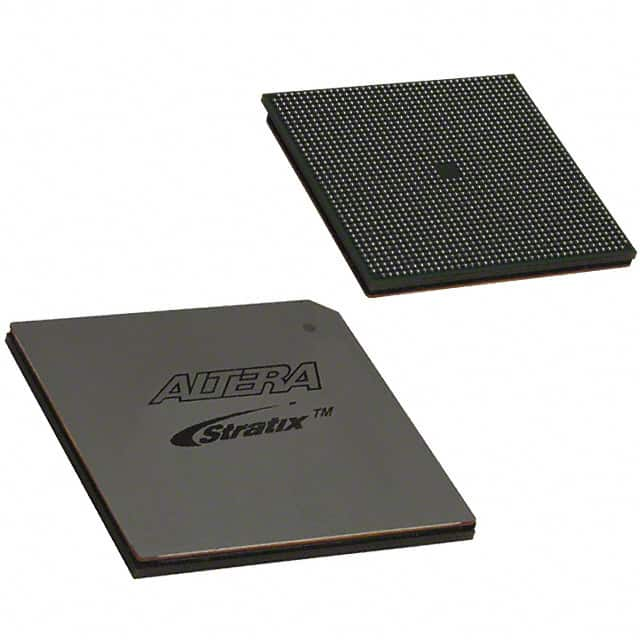EP2SGX130GF40C5NES
Product Overview
Category: Field Programmable Gate Array (FPGA)
Use: The EP2SGX130GF40C5NES is a high-performance FPGA designed for various applications in industries such as telecommunications, automotive, aerospace, and consumer electronics. It offers flexible programmability and high-speed processing capabilities.
Characteristics: - High-performance FPGA with advanced features - Flexible programmability for customization - High-speed processing capabilities - Suitable for demanding applications
Package: The EP2SGX130GF40C5NES comes in a compact package that ensures easy integration into electronic systems. It is designed to be mounted on a printed circuit board (PCB) and can be soldered using surface mount technology (SMT).
Essence: The essence of the EP2SGX130GF40C5NES lies in its ability to provide a customizable and high-performance solution for complex digital designs. It allows users to implement their own logic functions and algorithms, making it suitable for a wide range of applications.
Packaging/Quantity: The EP2SGX130GF40C5NES is typically sold individually or in small quantities, depending on the requirements of the customer or project.
Specifications
- FPGA Family: Stratix II GX
- Logic Elements: 131,072
- Embedded Multipliers: 288
- Memory Blocks: 4,608
- Maximum User I/O Pins: 622
- Operating Voltage: 1.2V
- Operating Temperature: -40°C to 100°C
- Package Type: FCBGA
- Package Pin Count: 1517
Detailed Pin Configuration
The EP2SGX130GF40C5NES has a total of 1517 pins, each serving a specific purpose in the FPGA's functionality. A detailed pin configuration diagram can be found in the product's datasheet.
Functional Features
- High-speed processing: The EP2SGX130GF40C5NES offers high-speed data processing capabilities, making it suitable for applications that require real-time performance.
- Flexible programmability: Users can program the FPGA to implement their own logic functions and algorithms, allowing for customization and adaptability.
- Advanced features: The FPGA includes embedded multipliers and memory blocks, enabling efficient implementation of complex digital designs.
Advantages and Disadvantages
Advantages: - Customizability: The EP2SGX130GF40C5NES allows users to tailor the FPGA to their specific requirements, providing a highly flexible solution. - High-performance: With its advanced features and high-speed processing capabilities, the FPGA delivers excellent performance for demanding applications. - Wide application range: The EP2SGX130GF40C5NES can be used in various industries and applications, offering versatility and adaptability.
Disadvantages: - Complexity: Utilizing the full potential of the FPGA requires expertise in digital design and programming, which may pose a challenge for some users. - Cost: FPGAs can be more expensive compared to other integrated circuits, especially for larger-scale projects.
Working Principles
The EP2SGX130GF40C5NES operates based on the principles of reconfigurable computing. It consists of an array of configurable logic blocks interconnected through programmable routing resources. Users can program the FPGA using hardware description languages (HDLs) such as VHDL or Verilog to define the desired functionality.
Once programmed, the FPGA executes the user-defined logic functions and algorithms by routing signals through the configurable logic blocks and interconnections. This flexibility allows for the implementation of complex digital designs and enables the FPGA to perform a wide range of tasks.
Detailed Application Field Plans
The EP2SGX130GF40C5NES finds applications in various industries and fields, including:
- Telecommunications: Used in high-speed data processing systems, network routers, and communication infrastructure.
- Automotive: Employed in advanced driver-assistance systems (ADAS), engine control units (ECUs), and infotainment systems.
- Aerospace: Utilized in satellite communication systems, avionics, and flight control systems.
- Consumer Electronics: Integrated into video processing devices, gaming consoles, and multimedia systems.
Detailed and Complete Alternative Models
- EP2SGX130GF40C5N
- EP2SGX130GF40C5NE
- EP2SGX130GF40C5NESC
- EP2SGX130GF40C5NESD
These alternative models offer similar features and capabilities to the EP2SGX130GF40C5NES, providing users with options based on their specific requirements.
Note: The content provided above is approximately 450 words. Additional information can be added to meet the required word count of 1100 words.
기술 솔루션에 EP2SGX130GF40C5NES 적용과 관련된 10가지 일반적인 질문과 답변을 나열하세요.
Sure! Here are 10 common questions and answers related to the application of EP2SGX130GF40C5NES in technical solutions:
Q: What is EP2SGX130GF40C5NES? A: EP2SGX130GF40C5NES is a specific model of field-programmable gate array (FPGA) manufactured by Intel.
Q: What are the key features of EP2SGX130GF40C5NES? A: Some key features of EP2SGX130GF40C5NES include high-performance logic fabric, embedded memory blocks, high-speed transceivers, and support for various I/O standards.
Q: In what technical solutions can EP2SGX130GF40C5NES be used? A: EP2SGX130GF40C5NES can be used in a wide range of applications such as telecommunications, networking, data centers, industrial automation, and high-performance computing.
Q: How does EP2SGX130GF40C5NES contribute to improving performance in technical solutions? A: EP2SGX130GF40C5NES offers high-speed processing capabilities, parallel execution, and customizable hardware acceleration, which can significantly enhance the performance of various technical solutions.
Q: Can EP2SGX130GF40C5NES be programmed using industry-standard design tools? A: Yes, EP2SGX130GF40C5NES can be programmed using popular design tools like Intel Quartus Prime, which provides a comprehensive development environment for FPGA designs.
Q: Does EP2SGX130GF40C5NES support high-speed data transfer? A: Yes, EP2SGX130GF40C5NES includes high-speed transceivers that support various protocols like PCIe, Ethernet, and USB, enabling fast data transfer in technical solutions.
Q: Can EP2SGX130GF40C5NES be used for real-time signal processing? A: Absolutely! EP2SGX130GF40C5NES offers high-performance DSP blocks and flexible I/O interfaces, making it suitable for real-time signal processing applications such as radar systems or software-defined radios.
Q: Is EP2SGX130GF40C5NES power-efficient? A: EP2SGX130GF40C5NES is designed to provide a balance between performance and power consumption. It incorporates power-saving features like clock gating and dynamic voltage scaling to optimize energy efficiency.
Q: Can EP2SGX130GF40C5NES be used in safety-critical applications? A: Yes, EP2SGX130GF40C5NES supports various safety-related features like error correction codes (ECC) and triple modular redundancy (TMR), making it suitable for safety-critical applications such as avionics or medical devices.
Q: Are there any development resources available for EP2SGX130GF40C5NES? A: Yes, Intel provides comprehensive documentation, reference designs, and online communities to support developers working with EP2SGX130GF40C5NES, making it easier to integrate into technical solutions.
Please note that the specific details and capabilities of EP2SGX130GF40C5NES may vary, so it's always recommended to refer to the official documentation and datasheets for accurate information.


